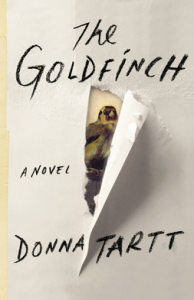When Donna Tartt’s much anticipated novel The Goldfinch hit bookstore shelves in 2013, the reaction was instantaneous.
Unwary shoppers found themselves caught up in the tidal wave of die-hard Tartt fans who had been waiting over ten years for her newest book. Together, they poured into stores, buying and ordering copies of the novel at accelerating rates. The book jumped onto the New York Times bestseller list and sat tight for nearly a year, selling over a million and a half print and digital copies, and drawing in rave reviews from the likes of Michiko Kakutani and Stephen King.
Because of the book, Tartt was named by Time magazine as one of the 100 most influential people in the world. The producers of The Hunger Games buckled down to create a film/television series based on the novel. New York’s Frick Collection, which had just begun exhibiting the painting for which the book was named, was suddenly accosted by throes of tourists who just wanted to see the piece of art that started it all.
But when The Goldfinch was entered into the running for the Pulitzer Prize for Fiction that year, that was the last straw. A mix of critics, simmering in a stewy silence, finally bubbled over the edge.
“Its tone, language, and story belong in children’s literature,” wrote The New Yorker book critic James Wood. According to Wood, the book was full of relentless, far-fetched plotting and stock characters, and was simply undeserving of the literary respect it had received.
“Tartt’s novel is not a serious one—it tells a fantastical, even ridiculous tale, based on absurd and improbable premises,” he said.
The Goldfinch did end up taking home the prestigious award, much to the dismay of many literary critics, who panned the novel just like Wood did. And so, the question was posed: Was our literary culture being infantilized? Were we finally sinking into a doomed world where adults read Harry Potter and Twilight instead of Moby-Dick and The Tale of Two Cities?
In a way, this concern made sense. The plot of The Goldfinch is certainly an outlandish one. The novel follows the troubled life of Theo Decker, whose world is turned upside down when he is swept up in a catastrophic event at an art museum in New York City that kills his mother. Panicked, thirteen-year-old Theo steals a famous painting, titled “The Goldfinch,” in order to save it during the chaos. Drawn into a life full of drugs and crime, Theo tumbles from New York to Las Vegas to Amsterdam, coming of age with a haunting secret: he is in possession of a piece of art that many are desperate to get their hands on.
But the supposed lack of “seriousness” of The Goldfinch did not stop readers from buying the book. It did not stop Tartt from enjoying wild literary success, achieving more attention and praise than any of her past books combined. Whether the critics liked it or not, the novel served as a catalyst for the shifting in literary tastes, an accurate representation of what the public wanted to read in the early 21st century.
Hate it or love it, The Goldfinch proves that people will read what they want to read. And if that means tossing “seriousness” to the wind, then so be it.
-Virginia Kettles
